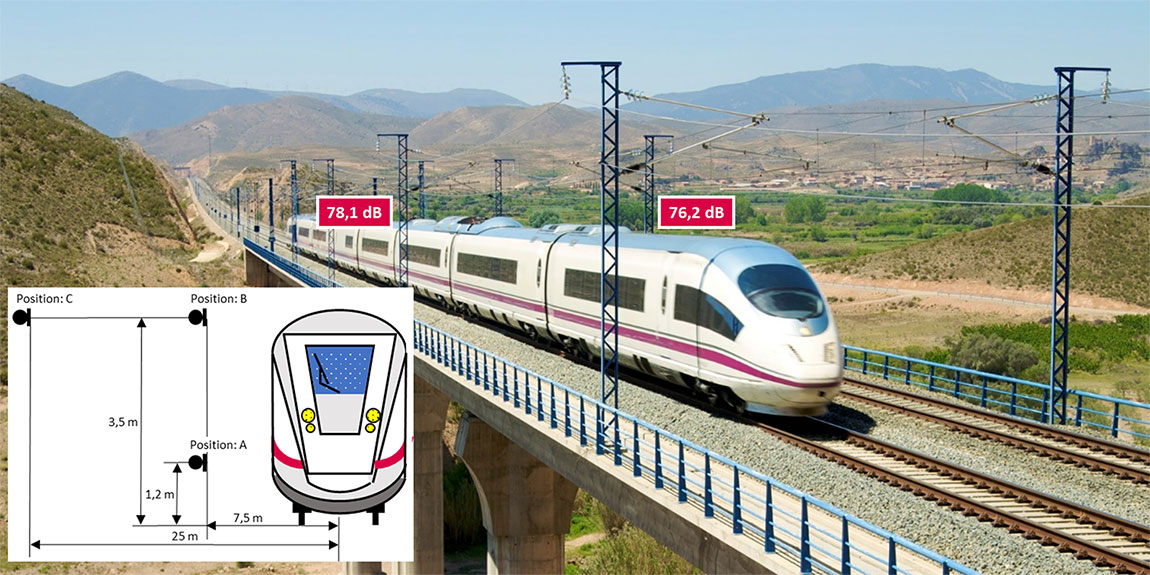Schall Emission von spurgebundenen Fahrzeugen nach ISO 3095
Die Schallemission von spurgebundenen Fahrzeugen ist ein wesentlicher Aspekt um die Akzeptanz des Eisenbahnverkehrs zu erhöhen. Der Lärm beeinflusst sowohl die Umwelt als auch die Lebensqualität der Anwohner. Die ISO 3095 ist die internationale Norm, die die Messung und Bewertung der Schallemission von Eisenbahnfahrzeugen regelt.

Überblick über die ISO 3095
Die ISO 3095 legt die Verfahren zur Messung des von spurgebundenen Fahrzeugen erzeugten Lärms fest. Ziel ist es, konsistente und vergleichbare Daten zu sammeln, um die Lärmbelastung zu bewerten und gegebenenfalls Maßnahmen zur Lärmminderung zu ergreifen. Die Norm gilt für alle Arten von Eisenbahnfahrzeugen, einschließlich Hochgeschwindigkeitszügen, Güterzügen und Straßenbahnen.
Es gibt drei verschiedene Messarten:
1. Messung im Stand:
Das von einer Zugeinheit im Stand abgegebene Geräusch ist von den Betriebsbedingungen abhängig. Güterwagen werden nur im Stand gemessen, wenn Hilfseinrichtungen wie Motoren, Generatoren oder Kühlsysteme vorhanden sind, beispielsweise bei Kühlwagen.

2. Messung beim Anfahren des Zuges
Bei der Typprüfung wird zwischen zwei Fällen von Zuganfahrgeräuschen unterschieden, zwischen dem Maximalpegel und dem Durchschnittspegel
- LpAFmax - maximaler Schalldruckpegel
- LpAeq,T - Schalldruckpegel



3. Messung bei konstanter Geschwindigkeit:
- Bei dieser Messung wird die Zugeinheit bei einer konstanten Vorbeifahrgeschwindigkeit gemessen. Bei der Typenprüfung wird zwischen zwei Fällen unterschieden:
- Zugeinheiten mit einer maximalen Geschwindigkeit (v_max) > 80 km/h, die Messungen erfolgen bei v_max.
Zugeinheiten mit einer maximalen Geschwindigkeit (v_max) ≤ 80 km/h, hier erfolgen Messungen bei v_max sowie zusätzlichen Geschwindigkeiten, beispielsweise in einem Bereich von 20 km/h bis 350 km/h.
Mikrofonpositionen:
![[Translate to Deutsch (de):] Positionierung der Messmikrofone in Abstand und Höhe](/fileadmin/Public/Applications/Rail/Mikrofonpositionen-min.jpg)
Messzeiten:
- Start: Die Vorderseite des Zuges löst die Messung mit einer Lichtschranke aus.
- Vor-Start: Beobachten Sie den Bereich vor dem Auslöser und schneiden Sie die Zeit aus, in der der SPL mindestens 10 dB niedriger war als beim Auslösestart.
- Stopp: Wenn der SPL 10 dB niedriger ist als der SPL zum Zeitpunkt der Auslösung.
Messgrößen:
- A-bewerteter äquivalenter Dauerschalldruckpegel (Mic_xxx_LAeq)
- A-bewerteter äquivalenter Dauerschalldruckpegel (Mic_xxx_L_Thirds_Aeq) Frequenzbänder: 31,5 Hz bis 20 kHz (8 kHz)
Für alle Messungen sind die akustischen Umgebungsbedingungen so zu gestalten, dass sich das Schallfeld frei ausbreiten kann. Die meteorologischen Bedingungen wie Windgeschwindigkeit und -richtung, Temperatur, Feuchte und Luftdruck sind zu dokumentieren. Jeder Niederschlag muss vermerkt werden.
Da die Messungen direkt an den Gleisen stattfinden, ist der Fremdgeräuschpegel zu messen und sicherzustellen, dass andere Geräuschquellen keinen signifikanten Einfluss auf die Messungen haben. Der Höchstwert des Fremdgeräusches (LpAeq,T mit T = 20 s) muss für alle Mikrofonpositionen mindestens 10 dB unterhalb des Gesamtgeräusches an jeder Mikrofonposition liegen.
Anforderungen der ISO 3095
Die ISO 3095 stellt verschiedene Anforderungen an die Durchführung von Schallmessungen:
- Geräteanforderungen
Kalibrierung: Messgeräte müssen vor und nach den Messungen kalibriert werden, um genaue und zuverlässige Daten zu gewährleisten.
Frequenzbereich: Die Geräte sollten in der Lage sein, den relevanten Frequenzbereich zu erfassen, typischerweise von 20 Hz bis 20 kHz. - Messprotokoll
Datenaufzeichnung: Alle relevanten Daten, einschließlich Wetterbedingungen, Zuggeschwindigkeit und genaue Position der Mikrofone, müssen dokumentiert werden.
Datenanalyse: Die erfassten Schallpegel müssen analysiert und in Bezug auf die entsprechenden Richtwerte und Grenzwerte bewertet werden.
![[Translate to Deutsch (de):] Anzeige einer Messfahrt mit Position der Messmikrofone und Ergebnisse der Spektralanalyse](/fileadmin/Public/Applications/Rail/Anforderungen-der-ISO-3095-min.jpg)
Fazit
Mit Hilfe von imvc WAVE erstellen Sie ein Experiment das der ISO 3095 eentspricht. Diese Norm ist ein wesentliches Instrument für die Lärmmessung und -bewertung von spurgebundenen Fahrzeugen. Durch die Einhaltung dieser Norm können Hersteller, Betreiber und Behörden sicherstellen, dass die Schallemissionen innerhalb akzeptabler Grenzen bleiben und somit zur Reduzierung der Lärmbelastung in der Umgebung beitragen.




